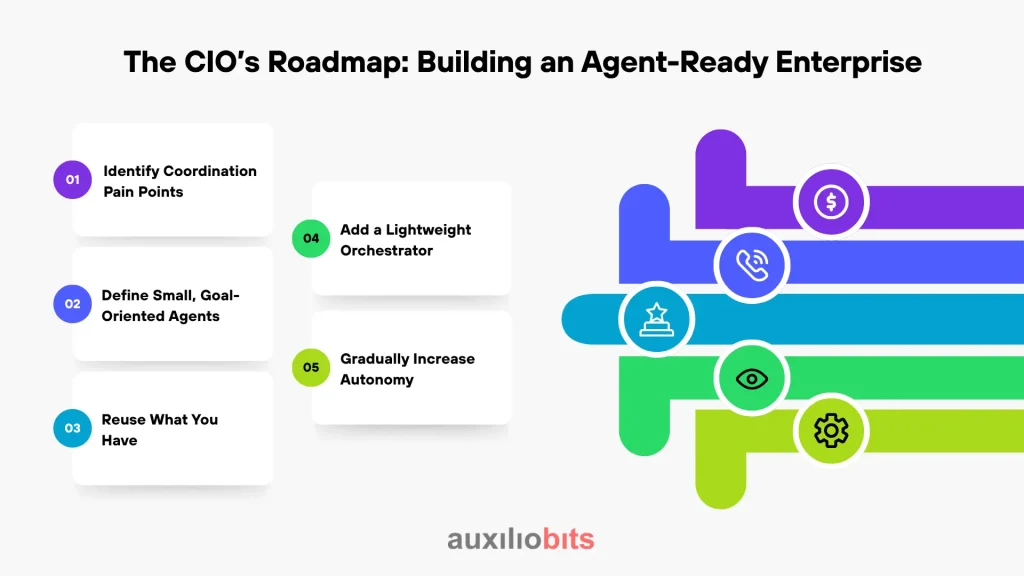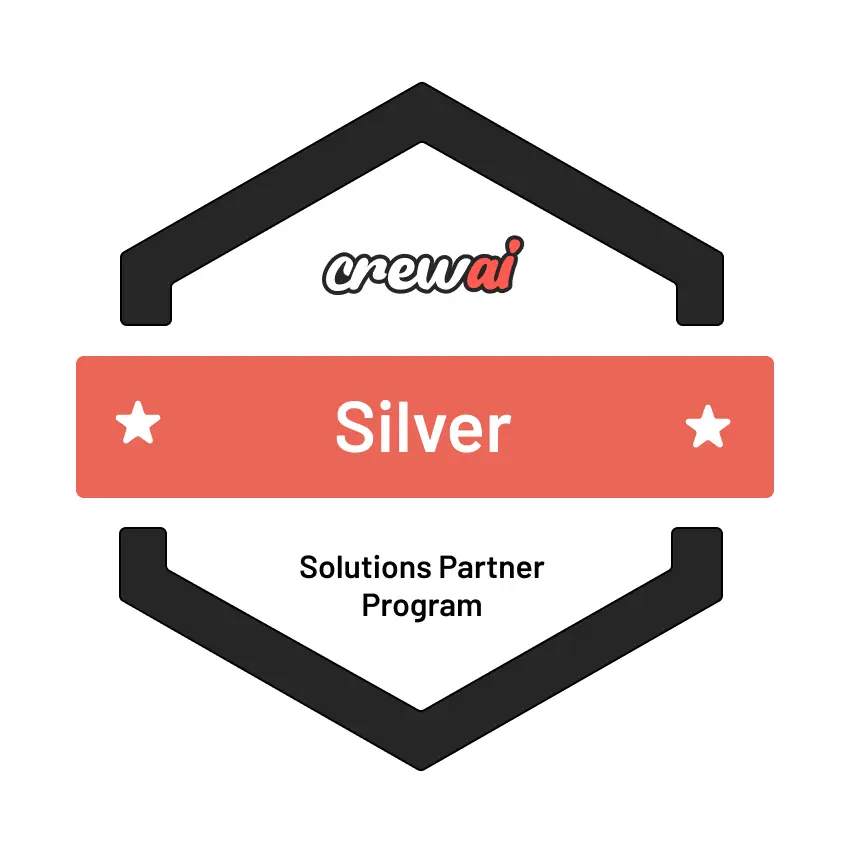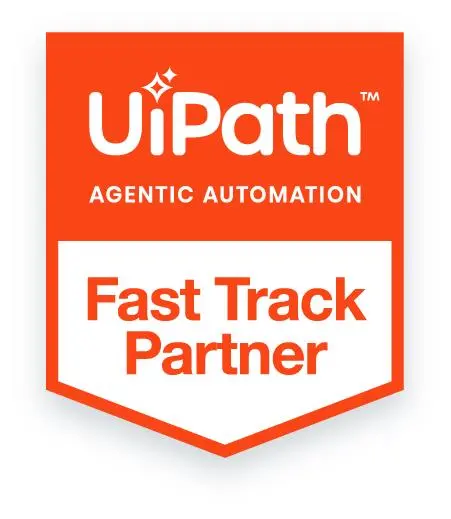
Key Takeaways
- Agent layers are not tools—they’re an architectural mindset. They create a reasoning fabric above existing systems, allowing enterprise software to coordinate, learn, and act without manual oversight.
- CIOs must evolve from system ownership to adaptability design. Future-proof strategies depend on enabling autonomy and cross-domain awareness, not just maintaining system uptime.
- Governance must modernize to match distributed intelligence. Explainable decision logs, policy boundaries, and rollback mechanisms become essential when agents start acting independently.
- Adoption succeeds when it starts small and grows trust. Pilot advisory-mode agents in well-understood domains—finance, procurement, or claims—and expand autonomy only after clear performance validation.
- Resilient architecture will look less like a static stack and more like a living organism. Agent layers enable systems to adapt dynamically, anticipate disruption, and evolve continuously without requiring top-down reengineering.
Every CIO lately seems to wrestle with the same paradox: the more digital their enterprise becomes, the more fragile it feels. Systems are connected, data flows everywhere, yet small changes ripple like earthquakes. A single API update breaks an entire chain of automations. A vendor change derails half of procurement.
For years, the answer was “build a stronger stack.” Buy an enterprise platform, add a data lake, wrap everything in APIs. But the truth is—we’ve reached the limits of stack thinking. You can’t keep layering systems without eventually turning the architecture into a Jenga tower.
The question has quietly shifted. It’s no longer What tools should we buy next? But how do we make our digital foundations adaptive enough to survive the next decade of change?
A growing number of CIOs are answering that with something deceptively simple: agent layers—a new architectural tier that sits above existing systems and allows them to reason, coordinate, and act independently.
Also read: Why Agent-First Architectures Will Define the Next Decade of Business Software
The Stack Problem No One Wants to Admit
We built automation on the promise of control. Everything had a process, every process had rules, and every rule could be coded. It worked for a while. But once your organization hits a few hundred systems, “control” quietly turns into “coordination debt.”
We have noticed:
- Finance runs RPA bots that depend on Excel macros three layers deep.
- The supply chain monitors a dozen dashboards that can’t talk to each other.
- Customer service uses five different workflow tools, each claiming to be the “single source of truth.”
It’s not incompetence. It’s the nature of enterprise software. Every team optimizes locally; no one manages the choreography globally.
That’s why CIOs are shifting focus from integrations to interactions. The difference? Integration is about connecting endpoints. Interaction is about letting systems understand context and intent—something traditional architecture can’t do on its own.
What an Agent Layer Actually Is
Forget the buzzwords for a minute. An agent layer isn’t another platform or dashboard. It’s a connective fabric — a layer of intelligent entities that can monitor what’s happening across systems, interpret meaning, and take action without waiting for a human or developer.
If traditional middleware moves data, an agent layer moves decisions.
Imagine this stack:
- Core Applications: ERP, CRM, HCM—the record systems that run your business.
- Automation Tools: RPA, iPaaS, scripts, and workflows—the machinery that executes rules.
- Agent Layer: A reasoning plane that observes, learns patterns, and triggers the right automations when something changes.
Each agent behaves like a digital colleague. One monitors supplier delays, another watches cash-flow anomalies, and another predicts compliance breaches. They aren’t “”apps”—they’re autonomous workers operating on top of your digital infrastructure.
The difference is subtle but profound. With automation, you tell the system what to do. With an agent layer, you tell it what to achieve, and it figures out how.
Why CIOs Are Paying Attention
Because resilience is no longer about redundancy—it’s about responsiveness. When something changes in the environment, your systems should adjust themselves faster than your teams can schedule a meeting.
Agent layers make that possible by doing three things well:
- Separating logic from systems. Business rules stop living inside ERP workflows. They live in the agent layer, where they can evolve independently. Swap your ERP? The agents still function.
- Embedding context. Agents see across domains. They know that a delayed shipment affects not just logistics but also billing, forecasting, and customer satisfaction.
- Learning continuously. Instead of one-time process updates, agents adjust behavior based on outcomes. They improve quietly, without large transformation projects.
When Agent Layers Make Sense (and When They Don’t)
Let’s be honest—not every organization is ready.
If your data landscape is still fragmented, or half your systems have no APIs, agents will spend most of their time guessing. Autonomy built on bad data is just faster chaos.
Cultural readiness matters too. Some teams still think in rigid approval chains; they’ll struggle with systems that “decide” things on their own. Early pilots work best when agents operate in advisory mode—suggesting actions before executing them. Once trust builds, autonomy follows naturally.
And there’s orchestration. When multiple agents run simultaneously, they can easily create deadlocks—one waiting for another’s output, or both editing the same object. Good agent architecture includes arbitration rules or coordination protocols. Without that, you’ve just created smarter silos.
In short: agent layers amplify whatever foundation you already have—clean data, clear goals, and disciplined automation. They can’t replace those fundamentals.
The CIO’s Roadmap: Building an Agent-Ready Enterprise
You don’t “buy” an agent layer; you evolve toward one. The most effective CIOs I’ve seen start quietly, in domains where automation already exists but lacks cohesion.

1. Identify Coordination Pain Points
Look for areas where multiple automations need human oversight—invoice validation, claim reviews, and vendor onboarding.
2. Define Small, Goal-Oriented Agents
Don’t start with an “enterprise AI agent.” Start with a role — Invoice Exception Handler, Risk Monitor, or Supplier Evaluator. Give it a narrow mission.
3. Reuse What You Have
Existing RPA bots, APIs, and scripts become the agent’s “hands.” You don’t rebuild them; you orchestrate them through reasoning.
4. Add a Lightweight Orchestrator
Think of it as traffic control—ensuring agents coordinate rather than collide. This could be a simple message bus or an event framework.
5. Gradually Increase Autonomy
First, agents observe. Then they recommend it. Eventually, they act. Each stage builds confidence and operational data for governance.
A New Kind of Governance
The move toward agents isn’t just technical; it changes how IT governance works.
Instead of monolithic control, you’ll manage distributed responsibility. Each agent has:
- Its own scope of authority.
- Its own decision limits.
- Its own compliance rules.
That means CIOs must design frameworks for explainability—how an agent justifies a decision—and for rollback, in case an action needs reversal. Traditional audit trails won’t cut it; you’ll need behavioral logs that record reasoning steps.This is where many pilots fail: they prove agents can act, but not that they can explain themselves. Without transparency, business users hesitate to trust them.
Rethinking the CIO’s Role
Agent layers quietly redefine what it means to lead technology. The CIO stops being the gatekeeper of tools and becomes the architect of adaptability.
It’s a subtle but important shift. You’re no longer asking, “Which system does this?” You’re asking, “Which layer should learn this?”
Some CIOs find that liberating; others find it unnerving. You have to let go of the idea that resilience equals control. The new game is about designing systems that self-correct faster than you can manually intervene
The Emerging Architecture: A Living Ecosystem
Once mature, an agent layer can change how enterprise systems behave entirely:
- Processes adapt in real time. When demand spikes, agents reroute resources automatically.
- Compliance updates propagate instantly. New regulations are parsed and applied by policy agents.
- User requests become intents, not tasks. A business analyst can type, “Generate quarterly forecast,” and an agent coordinates the systems to deliver it.
It sounds ambitious, but so did cloud migration in 2010. Ten years ago, self-healing infrastructure was aspirational. Now it’s standard. Agent layers extend that philosophy from infrastructure to business logic.
The Mistake Everyone Will Make
Vendors will overuse the word agent. Expect every chatbot, RPA script, and workflow engine to suddenly rebrand itself. CIOs should ignore the noise and use a stricter test:
- Does it perceive context beyond a single system?
- Can it explain its actions?
- Can it coordinate with other agents?
- Can it learn from results?
If the answer to those is “no,” it’s not an agent. It’s automation with marketing perfume.
A Final Thought
Future-proofing isn’t about guessing what’s next; it’s about building architectures that refuse to stay static. The irony is that true technological resilience feels a lot like biological evolution—messy, decentralized, and self-correcting.
Agent layers push enterprises closer to that model. They give systems room to interpret, react, and even improvise. And that might be uncomfortable for leaders used to total predictability. But the alternative—rigid architectures that crumble under change—is far worse.
The CIOs who get this right won’t be remembered for buying the latest AI tools. They’ll be remembered for designing organizations that never stop adapting.








